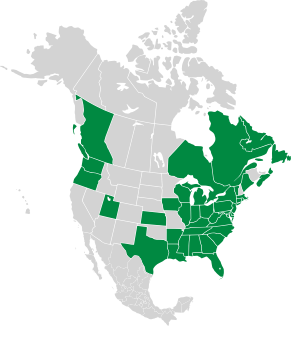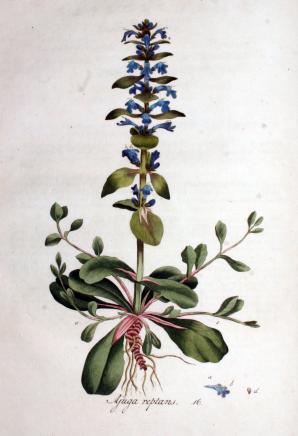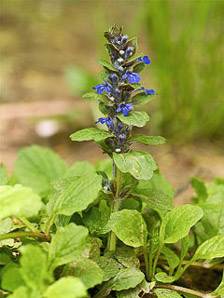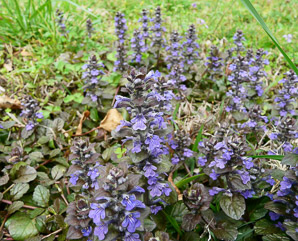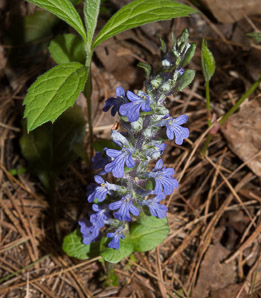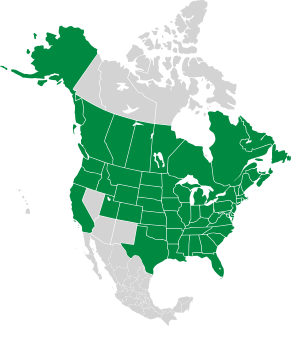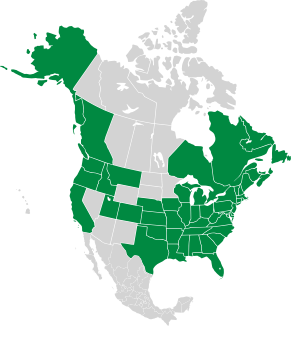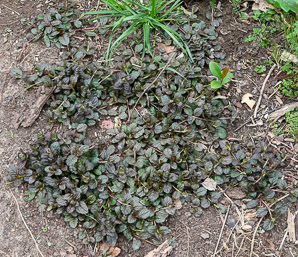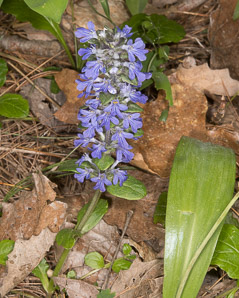
|
Ajuga reptans L. Bugle, blue bugle, bugleherb, bugleweed, carpetweed, carpet bugleweed, common bugle, carpet bugle
Carpet-bugle is a European native, grown as a groundcover and now naturalized in North America. In some areas it is considered an invasive. It prefers damp grassy fields, and damp woods. There are many cultivars. Identification: Carpet-bugle forms loose mats. Plants are 6-9″ (15-22 cm) in height. Leaves are dark green with purple highlights, opposite, and simple, sometimes toothed. Flowers are blue, appearing from May to Jun. Edibility: Poison Ajuga reptans. Jan Kops (1765–1849); illustrated by Christiaan Sepp, Flora Batava, Vol. 1, The Hague, 1800 |
4/3/2009 · Memphis, Tennessee · By Tim Chandler 5/20/2014 · Beaver Brook Assn Conservation Lands, Rte. 130, Hollis, New Hampshire · ≈ 5 × 8″ (12 × 19 cm) |
||||||||||||||||||||||||||||
|
Some similar species: | |||||||||||||||||||||||||||||
| You are here Ajuga reptans |
Glechoma hederacea |
Lamium purpureum |
|||||||||||||||||||||||||||
|---|---|---|---|---|---|---|---|---|---|---|---|---|---|---|---|---|---|---|---|---|---|---|---|---|---|---|---|---|---|
| Common Name |  |
 |
 |
||||||||||||||||||||||||||
| Plant | Forms loose mats. Plants are 6-9″ (15-22 cm) in height. | Often only 3″ (7.6 cm) tall, it sometimes reaches 12″ (30 cm). Extends horizontally, hence the term “ivy.” | 4-16″ (10-40 cm) high, and somewhat hairy. | ||||||||||||||||||||||||||
| Flowers | Blue, appearing from May to Jun. | Flowers are blue, purple, or lavender, occurring in groups of 3. The flower shape is unusual. A small upper petal is divided into two lobes. A larger lower petal has a lobe on either side, and a large bottom lobe that is divided into two more lobes. Each flower is ⅜-½″ (9.5-12 mm) across. | Flowers are ¼-¾″ (6.3-19 mm), appearing from Mar to Oct. They are pink to red to purple in color. | ||||||||||||||||||||||||||
| Leaves | Dark green with purple highlights, opposite, and simple, sometimes toothed. | Round or kidney-shaped, with scalloped edges, ⅜-1¼″ (9.5-31 mm) in diameter. | Toothed, round or kidney-shaped, deeply and irregularly veined, and ¼-1¼″ (6.3-31 mm). Each stem node has two opposite leaves, and each succeeded pair is rotated 90° from the last. Upper, younger leaves often have a red-violet tinge. | ||||||||||||||||||||||||||
| Stem | Square in cross-section. | Stems are 4-angled and glabrous. | |||||||||||||||||||||||||||
| Range/ Zones |
|
|
|
||||||||||||||||||||||||||
| Habitats | Damp grassy fields, damp woods. | Moist ground, woods, slopes, roadsides, waste places, lawns | Fields, weedy places, gardens. | ||||||||||||||||||||||||||
| Type | Wild | Wild | Wild | ||||||||||||||||||||||||||
| Occurrence | Common | Common | Common | ||||||||||||||||||||||||||
Prunella vulgaris

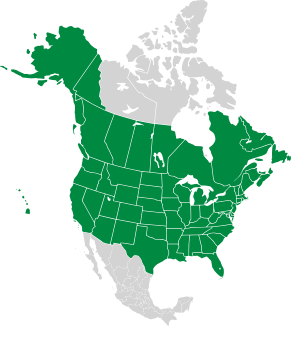
Online References:
Plants for a Future, a resource and information centre for edible and otherwise useful plants
References:
Clemants, Steven; Gracie, Carol, Wildflowers in the Field and Forest, Oxford University Press, 2006, p. 48
3/29/2008 · Memphis, Tennessee · By Tim Chandler 
Ajuga reptans description by Thomas H. Kent, last updated 16 Sep 2020.
© FloraFinder.org. All rights reserved.
5/18/2017 · Beaver Brook Conservation Area, Wildflower Trail, Hollis, New Hampshire · ≈ 4½ × 7″ (12 × 18 cm) 
Range: Zones 3-10:
